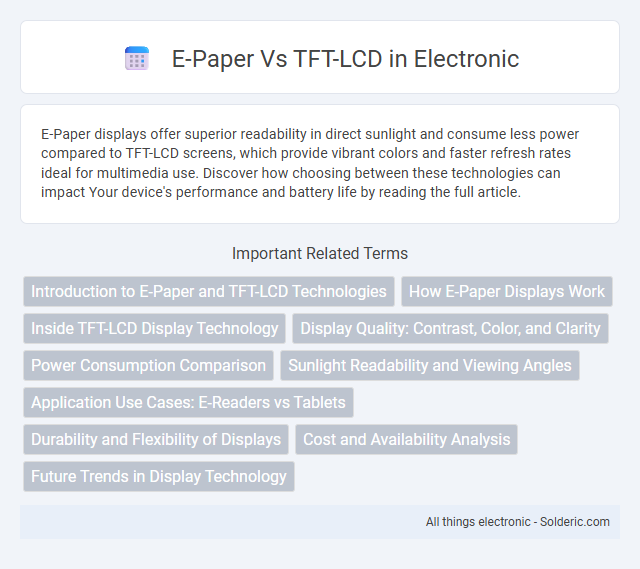E-Paper displays offer superior readability in direct sunlight and consume less power compared to TFT-LCD screens, which provide vibrant colors and faster refresh rates ideal for multimedia use. Discover how choosing between these technologies can impact Your device's performance and battery life by reading the full article.
Comparison Table
| Feature | E-Paper | TFT-LCD |
|---|---|---|
| Display Technology | Electrophoretic ink | Thin-Film Transistor Liquid Crystal Display |
| Power Consumption | Very low (bistable, only uses power on refresh) | High (constant backlight and pixel refresh) |
| Visibility | Excellent in sunlight (reflective) | Poor in direct sunlight (backlit, glare issues) |
| Color Capability | Limited (usually monochrome, some color e-paper variants) | Full color (millions of colors) |
| Refresh Rate | Slow (up to 1 second per screen update) | Fast (up to 60 Hz or more) |
| Durability | Fragile but low heat emission | Durable but higher heat emission |
| Use Cases | E-readers, signage, low-power devices | Smartphones, tablets, monitors, TVs |
Introduction to E-Paper and TFT-LCD Technologies
E-Paper technology mimics the appearance of ink on paper by using microcapsules that reflect ambient light, offering low power consumption and excellent readability in bright environments. TFT-LCD (Thin-Film Transistor Liquid Crystal Display) utilizes liquid crystals controlled by thin-film transistors to produce vibrant colors and high refresh rates, suitable for dynamic content and multimedia applications. Your choice between E-Paper and TFT-LCD depends on the need for energy efficiency and outdoor visibility versus vivid display performance and fast response times.
How E-Paper Displays Work
E-Paper displays function by manipulating microcapsules containing positively charged white particles and negatively charged black particles suspended in a clear fluid, which are controlled via electric fields to form images with high contrast and low power consumption. Unlike TFT-LCDs that use backlighting and liquid crystals to modulate light, E-Paper reflects ambient light, resulting in excellent visibility even in direct sunlight and minimal energy use since power is only needed when updating the display. This bistable property allows E-Paper screens to maintain an image without continuous power, making them ideal for e-readers, signage, and low-energy applications.
Inside TFT-LCD Display Technology
TFT-LCD display technology uses a matrix of thin-film transistors to control individual pixels, allowing for high-resolution color images with fast refresh rates. Inside a TFT-LCD, liquid crystals modulate light from a backlight to produce vibrant visuals, while the thin-film transistors act as switches to selectively allow light through each pixel. Understanding this structure can help you appreciate the differences in power consumption and image persistence compared to E-Paper displays.
Display Quality: Contrast, Color, and Clarity
E-Paper displays offer exceptional contrast with true blacks and high readability under direct sunlight due to their reflective nature, making them ideal for static images and text-heavy content. TFT-LCDs provide vibrant, full-color output with high brightness and sharp resolution, suitable for dynamic multimedia and video playback. While TFT-LCDs deliver superior color accuracy and clarity for fast-changing images, E-Paper excels in eye comfort and visibility in various lighting conditions without glare.
Power Consumption Comparison
E-Paper displays consume significantly less power than TFT-LCD screens because they only use energy when updating the image, making them ideal for battery-powered devices requiring long standby times. TFT-LCDs, on the other hand, continuously draw power to maintain backlighting and refresh the screen, resulting in higher energy consumption. Your device's battery life can be greatly extended by choosing E-Paper for static content display, especially in e-readers and low-power applications.
Sunlight Readability and Viewing Angles
E-Paper displays excel in sunlight readability due to their reflective technology, allowing clear visibility without backlight, making them ideal for outdoor use. TFT-LCD screens rely on backlighting, which often results in glare and reduced clarity under direct sunlight, limiting their effectiveness in bright environments. Viewing angles on TFT-LCDs are generally wider and more vibrant, while E-Paper displays tend to have narrower angles but maintain consistent contrast without color distortion.
Application Use Cases: E-Readers vs Tablets
E-Paper displays excel in e-readers due to their low power consumption, excellent readability in direct sunlight, and paper-like visual comfort, making them ideal for prolonged reading sessions. TFT-LCDs dominate tablet applications by offering vibrant colors, high refresh rates, and versatile multimedia support critical for video playback, gaming, and interactive apps. The choice between E-Paper and TFT-LCD hinges on the primary use case: static text and low power for e-readers versus dynamic visuals and fast response times for tablets.
Durability and Flexibility of Displays
E-Paper displays offer superior durability and flexibility compared to TFT-LCD screens, making them ideal for rugged and portable applications. Their flexible substrates allow bending without damage, unlike the rigid glass layers in TFT-LCDs, which are more prone to cracking under stress. Your choice of display should consider E-Paper for long-lasting, resilient use where flexibility is crucial.
Cost and Availability Analysis
E-Paper displays typically have lower power consumption and are cost-effective for applications requiring static images, making them economically suitable for eReaders and signage. TFT-LCD panels offer broader availability and versatility with vibrant color reproduction but come at higher manufacturing costs due to complex backlighting and active matrix components. Market trends indicate TFT-LCDs dominate mass consumer electronics, while E-Paper remains specialized, influencing availability and price competitiveness.
Future Trends in Display Technology
E-Paper technology offers superior energy efficiency and readability in bright environments, making it ideal for low-power devices and e-readers, while TFT-LCDs continue to dominate with vibrant colors and fast refresh rates suitable for multimedia applications. Emerging trends indicate flexible and foldable displays incorporating both E-Paper and TFT-LCD advancements, enhancing portability and user experience. Your choice will depend on balancing power consumption needs with display performance as these technologies evolve in future electronic devices.
E-Paper vs TFT-LCD Infographic

 solderic.com
solderic.com